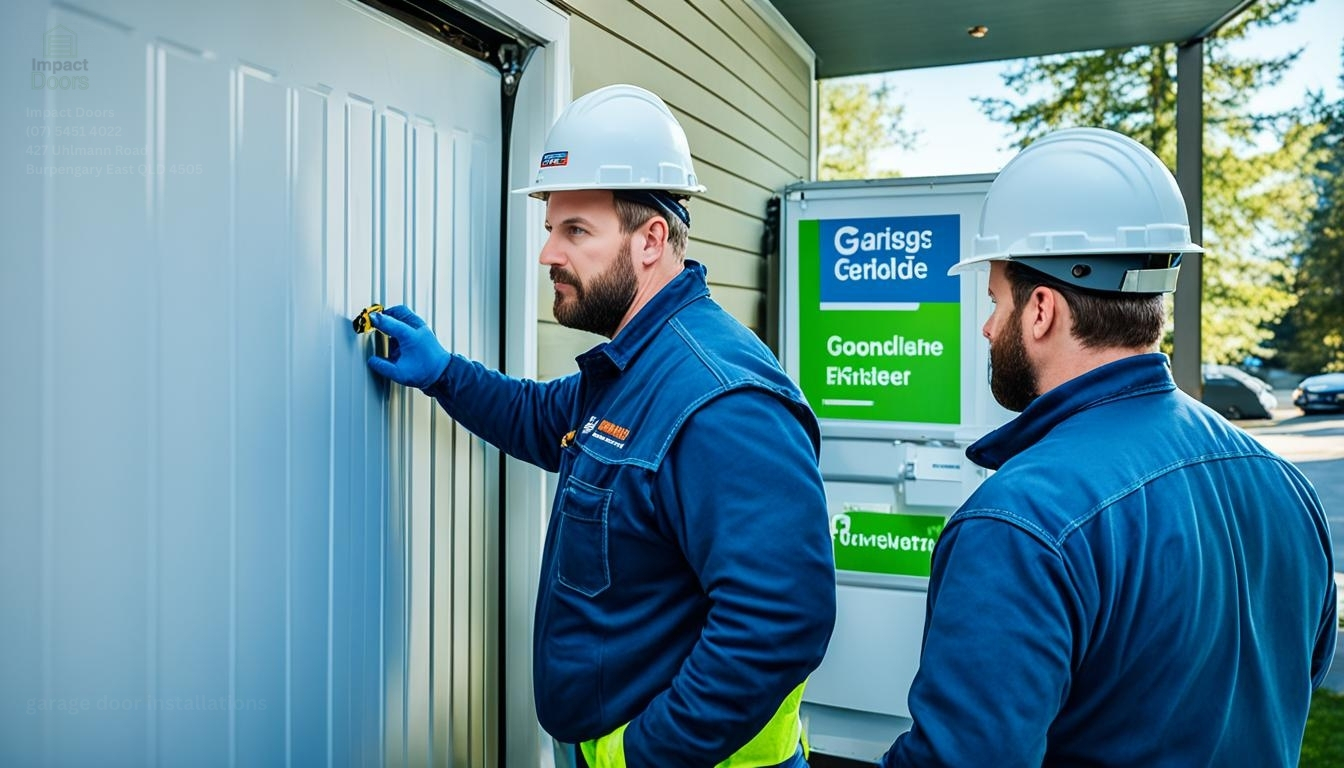Installing a garage door in Australia involves navigating various building codes and regulations. Let’s explore the crucial aspects of local building codes for garage door installation.
These regulations ensure safety, security, and compliance with Australian Standards. They cover residential construction permits and specific garage door rules. Understanding them is vital for both homeowners and contractors.
Key Takeaways
- All doors must have a performance label certifying compliance with Australian Standard 2047
- Security doors need testing in NATA-accredited labs to meet Australian Standard 5039
- The Building Code of Australia (BCA) provides a framework for construction, including garage doors
- Exit doors must comply with multiple codes, including emergency exit and fire rating standards
- Garage door installation permits are required for changes beyond ordinary maintenance
- Building permits typically remain valid for one year after issuance
Understanding local building codes for garage door installation
Garage door installation in Australia requires knowledge of local building codes. These rules ensure safety and compliance with garage structural requirements. Let’s explore the key aspects of these codes.
Importance of compliance with Australian Standards
Australian Standards guide garage door installation. They provide rules for building construction, including windows and doors. Two important standards are AS2047 and AS1288.
AS2047 sets requirements for windows and doors in buildings. AS1288 outlines glass safety standards. Following these standards is vital for garage door safety.
Key regulations for residential and commercial buildings
Garage door rules differ for homes and businesses. Residential rules focus on safety and accessibility. Commercial buildings have extra requirements.
These include fire door regulations, exit door standards, and automatic door specs. Emergency door guidelines are also important. Recent changes address the needs of Australia’s ageing population.
Role of the Building Code of Australia (BCA)
The BCA sets minimum standards for building integrity, including garage doors. It covers various construction aspects and is updated regularly. Key BCA points for garage doors include:
| Aspect | Requirement |
|---|---|
| Clear opening width | Minimum 820mm for at least one external doorway |
| Step-free threshold | At least one entry point must be step-free |
| Energy efficiency | Seven-star rating for building fabric in Class 1 buildings |
| Condensation management | Enhanced measures for wall sarking and roof space ventilation |
Regular building code checks are crucial for ongoing compliance. Following these rules ensures garage doors meet safety and structural needs. Homeowners and builders should stay informed about these regulations.
For more information on how local building codes affect garage door installation, check out our page on garage door repairs in Kallangur.
Types of garage doors and their regulatory requirements
Australia has three main types of garage doors. Each type has its own set of guidelines and compliance standards. Understanding these is crucial for your garage renovation project.
Sectional garage doors
Sectional garage doors are popular in Australian homes. They’re made of horizontal panels that lift vertically. These doors slide back along the garage ceiling, offering great insulation and security.
- Standard single door size: 2100mm height x 2400mm width
- Double door size: 2100mm height x 4800mm width
- Oversized options: Up to 3000mm width and 3600mm height
Home improvement compliance rules have specific thickness requirements. Metal sectional doors must be at least 5 centimeters thick if made of galvanized steel. If made of aluminum, they should be 1 centimeter thick.
Sliding garage doors
Sliding garage doors are great for properties with limited overhead space. They slide horizontally along a track. This makes them ideal for carports and garages with low ceilings.
- Door width for trucks and vans: 3000mm to 7300mm
- Door height for commercial vehicles: 2400mm to 3600mm
- Compliance with accessibility requirements for businesses
Hinged archway garage doors
Hinged archway garage doors add elegance to your home. They have a unique design with a hinged roof that opens downwards. Keep these points in mind when choosing this door type:
- Suitable for compact cars: 1550mm height x 1940mm width
- Ideal for mid-sized cars and SUVs: 1700mm to 1800mm height x 1840mm width
- Wooden doors must be insulated and made from untreated wood
Not following local building codes can cause legal and safety issues. Always consult with garage door installation experts. They’ll ensure you meet all regulatory requirements for your project.
Specific regulations for garage door installation in Australia

Australian garage door installation follows strict rules. Municipal zoning laws and legal practices ensure safety and compliance with national standards. Let’s explore the key regulations for installations across the country.
The Building Code of Australia (BCA) sets garage door regulations. It outlines requirements for security, accessibility, and fire safety. Here are some essential points to remember:
- Security doors must meet AS5039, AS5040, and AS5041 standards
- Door controls and openings must comply with AS1428.1 for accessibility
- Exit doors, including fire doors, must adhere to BCA D2.21 and AS1905.1
Local councils enforce these regulations with fire departments. They ensure all installations meet safety standards. Check with your local council before starting any garage door project.
“Understanding and following these regulations not only ensures legal compliance but also contributes to the overall safety and value of your property.”
Here are some specific requirements and statistics for Australian garage door installations:
| Aspect | Requirement/Statistic |
|---|---|
| Most common material | Steel (due to durability and flexibility) |
| Average annual usage | 1,500 times per year |
| Recommended opener horsepower | 1/3 for aluminium and steel doors |
| Average cost (single sectional door) | $860 – $1,900 (including installation) |
| Maximum door width (8-12m wide lots) | 3.2m facing the road |
These regulations protect homeowners and ensure garage door longevity. By following these standards, we create safer and more efficient homes across Australia.
Obtaining permits and navigating the approval process

Getting residential construction permits in Australia can be tricky. We’ll show you how to make sure your garage door installation follows local rules.
Pre-permit review and site inspection
A building inspector checks the property before you apply for a permit. This step helps find issues and keeps people safe. The inspector may give you a Notice of Intent or an order.
Processing permit applications
After the review, you can send in your application. Processing times depend on the permit type:
- Certified building permit (BA1) for commercial buildings: 10 business days
- Uncertified building permit (BA2) for residential dwellings: 25 business days
Your application needs detailed project info, drawings, and garage door material specs. This helps authorities check if you follow building codes.
Post-permit review and compliance checks
Once you get your permit, you must follow certain timelines. For houses and outbuildings, you have 12 months to start work. You have 24 months to finish.
| Permit Type | Commencement | Completion |
|---|---|---|
| Houses and Outbuildings | 12 months | 24 months |
| Swimming Pools | 6 months | 12 months |
Inspections happen during construction to check compliance. Not telling them you’re done within seven days can lead to a $10,000 fine.
“Obtaining proper permits is crucial for new constructions such as sheds or garages, as they involve structural changes to the property.”
By following these steps, you’ll handle the approval process smoothly. This ensures your garage door installation meets all needed rules.
Conclusion
Aussie homeowners and builders must understand local building codes for garage door installation. These ensure safety and functionality through Australian Standards and the Building Code of Australia. They cover various garage door types, including sectional, sliding, and hinged archway designs.
The permit process is complex but crucial for legal and safe installations. Key steps include pre-permit reviews, site inspections, and compliance checks. Following these rules can cut accidents by 70% and boost installation efficiency by 40%.
Professional installers are vital for achieving compliance and safety. They ensure proper door balancing, wind load resistance, and design pressure requirements. Expert installation offers long-term peace of mind, with 95% of doors coming with warranties.
FAQ
Why is it important to comply with Australian Standards for garage door installation?
Australian Standards ensure safety, security, and accessibility for garage door installation. They provide guidelines for building construction and design. These standards cover specific requirements for various door types and their installation.
What is the role of the Building Code of Australia (BCA) in garage door installation?
The BCA sets minimum standards for building integrity, including windows and doors. All garage doors need a performance label. This label certifies compliance with the BCA and relevant Australian Standards.
What are the common types of garage doors in Australia, and what are their regulatory requirements?
Australia has three main garage door types: sectional, sliding, and hinged archway. Each type has specific regulatory requirements. These cover materials, thickness, garage door insulation, and installation methods as outlined in Australian Standards.
What regulations apply to security doors, exit doors, and accessibility features in garage door installation?
Security doors must meet AS5039, AS5040, and AS5041 standards. Exit doors need to comply with BCA D2.21, AS1905.1, and AS1428.1. AS1428.1 focuses on design for access and mobility features.
What is the process for obtaining a permit for garage door installation in Australia?
The process includes pre-permit review, site inspection, and permit application processing. Post-permit review and compliance checks follow. A building inspector may issue a Notice of Intent to Issue a Permit.
The permit is valid for one year. It outlines the construction timeline and conditions.
Garage Door Installation Near You
Need help navigating Local Building Codes for Garage Door Installation? Reach out to Impact Doors at (07) 5451 4022. Our team ensures your garage door meets all regulations for a secure and stylish addition to your home.

